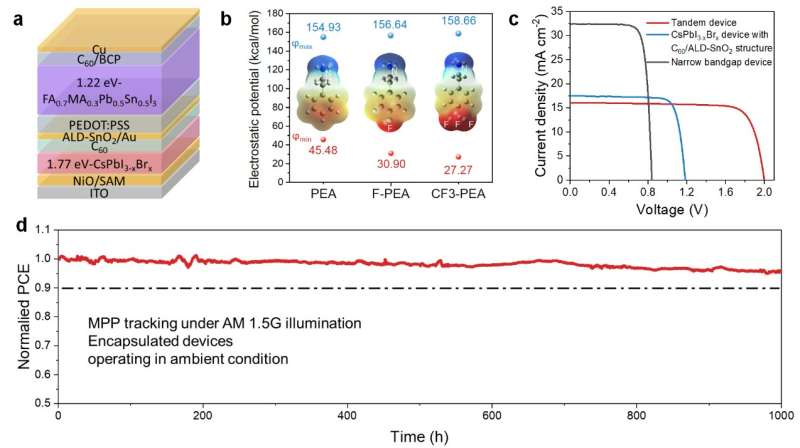Researchers at Nanjing University and the University of Toronto have developed inorganic wide-bandgap perovskite subcells to enhance the efficiency and stability of solar cells.

All-perovskite tandem solar cells stack p-n junctions of perovskites with different energy bandgaps, promising higher efficiencies than single-junction cells. Yet, proposed cells often need more power conversion efficiencies (PCEs) due to challenges in creating suitable narrow- and wide-bandgap subcells.
Researchers at Nanjing University and the University of Toronto have developed inorganic wide-bandgap perovskite subcells that could improve the efficiency and stability of these potential solar cells. All-inorganic CsPbI3-xBrx perovskites have superior thermal and photostability compared to hybrid organic-inorganic perovskites. The team utilized these materials in their study to develop all-perovskite tandem solar cells with enhanced long-term operational stability by creating inorganic wide-bandgap subcells.
Inorganic wide-bandgap perovskites have higher conduction band minimums than equivalent hybrid perovskites, resulting in a large conduction band offset (~0.7 eV) at the perovskite/electron-transport layer interface. This offset hinders charge extraction, causing significant open-circuit voltage (VOC) losses and hysteresis in the J-V curves. To improve band alignment and increase binding strength between inorganic perovskite and C60 contacts, we added a high molecular polarity dipole layer (CF3-PEA) at the perovskite/C60 interface to reconfigure interfacial states.
The dipole layer introduced by the team between organic and inorganic materials is the subcell design’s most distinct feature, addressing interfacial transfer issues in all-perovskite tandem solar cells. PEA passivators commonly used to interface organic and inorganic perovskites hinder crucial transfer for stable cell function. In contrast, the high polarity dipole CF3-PEA layer introduced by the researchers promotes interfacial transfer, notably boosting cell PCE. Using their design strategy, the researchers developed a highly promising 18.5% PCE wide-bandgap cell. They then created all-perovskite tandem solar cells using this subcell, achieving a PCE of 25.6%. After 1,000 hours of simulated sun operation, the cells retained 96% of their initial performance, as discovered by the team. Their design may guide the development of more efficient and durable all-perovskite tandem solar cells.
The researchers stated that inorganic wide-bandgap perovskites advance the operating stability of all-perovskite tandems, but more work is needed to increase their PCEs beyond 30%. To achieve this, the VOC of the wide-band gap front subcell must be improved beyond 1.23 V by suppressing bulk and surface recombination. In the future, combining computational and experimental efforts could lead to the rational design of efficient passivators.
References : Tiantian Li et al, Inorganic wide-bandgap perovskite subcells with dipole bridge for all-perovskite tandems, Nature Energy (2023). DOI: 10.1038/s41560-023-01250-7
Renxing Lin et al, All-perovskite tandem solar cells with improved grain surface passivation, Nature (2022). DOI: 10.1038/s41586-021-04372-8









